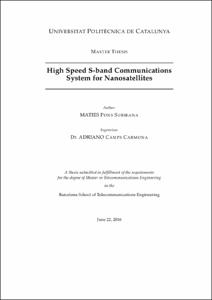High Speed S-band Communications System for Nanosatellites
Tipus de documentProjecte Final de Màster Oficial
Data2016-06-22
Condicions d'accésAccés obert
Tots els drets reservats. Aquesta obra està protegida pels drets de propietat intel·lectual i
industrial corresponents. Sense perjudici de les exempcions legals existents, queda prohibida la seva
reproducció, distribució, comunicació pública o transformació sense l'autorització del titular dels drets
Abstract
In order to accomplish the objectives of the next generation of nanosatellites high-speed downlinks have to be designed. This goal faces stringent design constraints as nanosatellites are limit in power, processing capabilities and dimensions. In the quest for higher bit rates the widely used VHF band has to be replaced for higher frequency bands and the link budged margin tightened, decreasing the SNR at reception. The proposed solution uses COTS 2.4 GHz WiFi adapters as transceivers. Range limitations imposed by the default 802.11 mode of operation are bypassed by using packet forging and injection at transmission jointly with monitor mode at reception. A loss-resilient unidirectional downlink is achieved by using application-layer encoding by means of LPDC-Staircase codes. This solution has been already implemented in 3CAT-2, a 6 unit cubesat GNSS-R mission to be launched in July 2016. In addition, bursts of errors are combated by using Reed-Solomon. The system has been tested under Doppler shift and scintillation effects, and a 188Km link between Barcelona and Mallorca has been performed, showing satisfactory results.
Descripció
3Cat-3 is a nanosatellite based on the 6 unit cubesat standard. Its payload is an optical multispectral imager that imposes stringent downlink requirements for a nanosatellite. This TFG is based on the experience gained in 3Cat-1 and 3Cat-2 communications systems to develop a "high speed" (goal >= 5 Mbps) downlink for nanosatellites based on the TI CC3200.
TitulacióMÀSTER UNIVERSITARI EN ENGINYERIA DE TELECOMUNICACIÓ (Pla 2013)
Col·leccions
| Fitxers | Descripció | Mida | Format | Visualitza |
|---|---|---|---|---|
| WorkplanMatiesPonsSubirana.zip | 10,57Mb | application/zip | Visualitza/Obre | |
| MasterThesisMatiesPonsSubirana.pdf | 11,23Mb | Visualitza/Obre |


